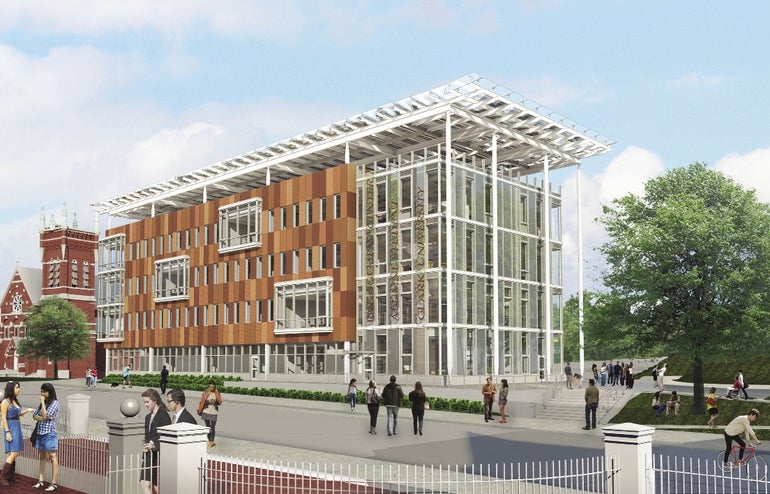Amid a growing need for more space and facilities, Worcester’s colleges have undertaken multi-million-dollar projects that are lifting up individual neighborhoods in the city.
In Main South, Clark University is about to embark on its $23.8 million Alumni and Student Engagement Center as the school continues to expand its footprint into the surrounding neighborhood. Downtown, Quinsigamond Community College (QCC) has taken up residence in the former Telegram & Gazette building, bringing students and administrators downtown.
Taken together, these projects are building up the image of Worcester as a college city, as opposed to a city that simply has a few colleges.
“We’ve always thought that Worcester had the potential to be a college town more than it demonstrates,” QCC President Gail Carberry said, summarizing the attitude of the city’s higher-education institutions. “The downtown hub of Worcester is becoming more and more a college presence and will increasingly show that.”
The opportunity for schools to lift up Worcester is always a consideration when they undertake improvement projects, she said. While the colleges must do everything with their students in mind, the schools have as much to gain from improvements in the city as Worcester has from cultivating its colleges and universities, said Barry Maloney, president of Worcester State University. This has led both academic and city officials to work together on school projects.
With colleges spread throughout the city, they’re able to anchor and improve individual neighborhoods, boosting the entire city, added Timothy Murray, president and CEO of the Worcester Regional Chamber of Commerce.
Clark’s work in Main South has improved a neighborhood that has seen tough times, he said. That was a conscious move on the school’s part, said Jack Foley, vice president for government and community affairs and campus services. Foley is overseeing the school’s Alumni and Student Engagement Center, slated for completion in 2016. While that project will benefit students by offering more space for informal meetings and centralizing many student services under one roof, the surrounding neighborhood was part of the planning process, he said.
“This will bring great lighting to that area and stabilize that area … it will be a real beacon … making this a safe anchor,” Foley said.
Strong neighborhoods can anchor parts of the city, Maloney added. And this effect continues to grow in Worcester as schools expand beyond their core campuses.
When QCC expanded into downtown, boosting the economy by bringing more people to the center of the city was a strong consideration, Carberry said. The need for the expansion was a direct result of both growing attendance — up 50 percent to 12,000 since 2006 — and the demand for workforce development that the 73,000-square-foot facility on Franklin Street addresses.
“That was a big factor for us: How could we better support the revitalization of downtown?” Carberry said. “We needed the physical space and we thought downtown was the best place to do it.”
QCC and Becker College, which is planning to renovate a building into a center for innovation and entrepreneurship, have joined the ranks of WPI, MCPHS University and Clark in creating a larger impact when their expansions are taken together, Carberry said.
These locations can help draw more students, which means a more vibrant downtown with more customers for businesses, Murray said. While the buildings send a strong message, the people in them have the ability to effect significant change, he added.
“Symbolically, having those fresh buildings is important but equally important, especially to the businesses, is having those people downtown,” Murray said. “Businesses want to be where there is a well-educated and well-trained workforce. We have that, but students and often times those businesses want to be in places where there is that feel and that atmosphere.”
Signature buildings
While the city’s well-being is a consideration with schools’ projects, serving students must be at the forefront, according to officials from the colleges. Current projects improve or expand student programming and, in some cases, act as “signature” buildings that draw attention through their architecture or the individual programs within them, enhancing the schools’ marketing and admissions efforts.
Some schools have entered into an “arms race” of sorts, creating expensive facilities that are used to market the school. For example, the University of Massachusetts Boston recently completed a $182 million science complex.
These signature buildings will be plastered over every marketing brochure for a school, said Charles “Chick” Weiss, director of the Office of Strategic Initiatives & Corporate & Foundation Relations at Holy Cross, which recently secured a top design firm to create a signature building for its new arts center.
However, he and Foley, at Clark, don’t see their current projects as being without substance. Rather, they see them as creating spaces that enhance student life.
Yet, the Holy Cross building will also enhance Worcester’s performing arts scene through accessible theater and concerts, Weiss said.
With the upcoming addition of the performing arts center and other higher-education projects in the city, the boost to the city’s economy and communities from local colleges will only continue to grow, Murray said.
“The college and university (facilities) that have been built have begun to change the dynamic and perception of the city … symbolically, having those fresh buildings is important,” he said. “There’s no doubt that when (schools) are engaged and partnering with business and neighborhood groups, that you can make some real good things happen and we have.”

